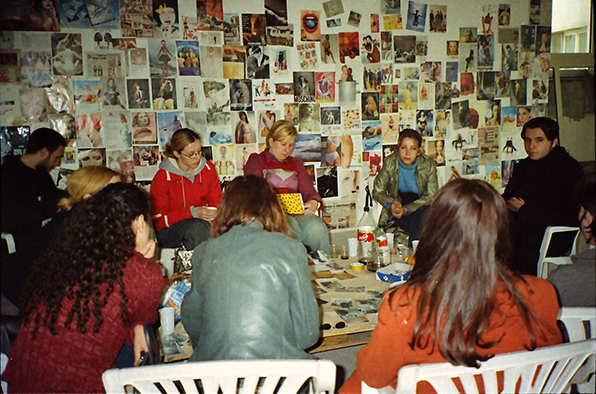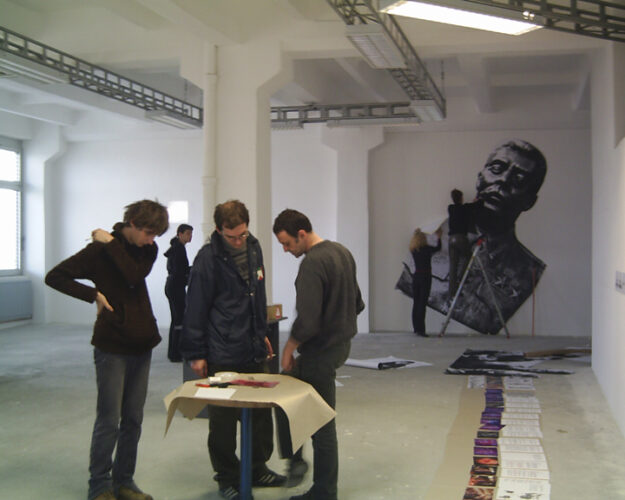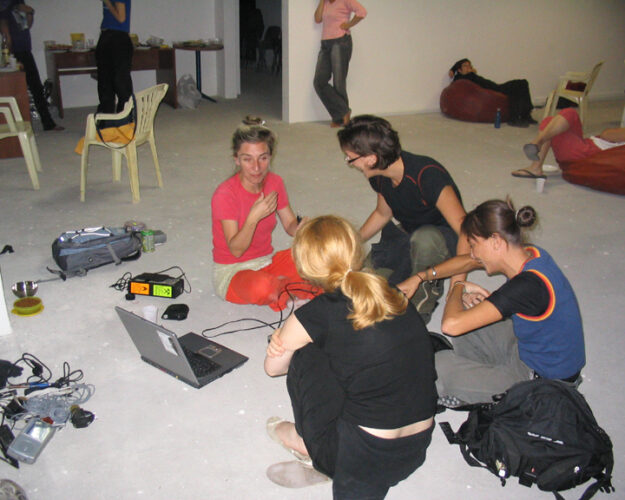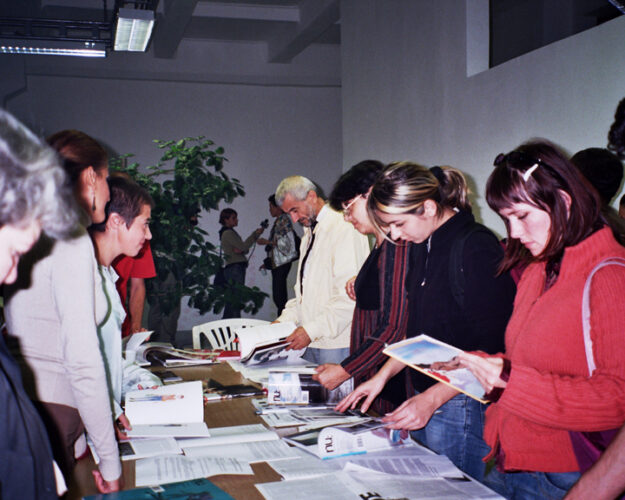Gabriela Mateescu continues the series of investigations regarding the spaces coordinated by artists in Timișoara and talks with the artists from the h.arta group (Maria Crista, Anca Gyemant and Rodica Tache), who coordinated the h.arta space between 2001 and 2006.
“We have been working together since 2001, when we founded the h.arta space, a non-profit space in Timișoara. h.arta has sometimes been a physical space, but often its projects take different formats, such as text-based installations, video films, or performances, all in different contexts and locations. We are interested in topics such as knowledge production, (re)writing histories, feminism and anti-speciesism in times of climate emergency. The h.arta group is based on our friendship, on a daily negotiation of our differences. We use friendship as a way to learn together how to recognize the different nuances of each situation, as a safe space, as a feminist family model, as a political statement about the power of solidarity.”
The h.arta space operated in a former industrial hall in Timișoara, between 2001-2006, during which various events took place here, such as exhibitions, debates, presentations, workshops, which aimed to question the role of art and what is the link between art and everyday life. At the end of 2006, the h.arta space in its original form closed, but its questions and issues continued to be explored in other formats and locations, such as Project Space in Bucharest in 2007 and Feminisme space in Timișoara, in 2008-2009.
Gabriela Mateescu, artist, curator and editor of ARTA magazine, continues the research started in 2022 in ARTA Magazine issue 54-55 on the topic of spaces coordinated by artists in Romania. This time, Gabriela decided to contact several spaces in Timișoara and talk to their coordinators about the challenges they have encountered since their establishment and in some cases closure.
This investigation wants to reveal a number of important aspects related to the organisation of cultural events in such spaces, how they have evolved over time – highlighting their history, why they closed, how they manage to survive, or how they adapted to socio-cultural changes. And last but not least, the research dwells on how these spaces have influenced and contributed to the development of the artistic community in Timișoara, supporting emerging artists and local cultural projects. The research will materialise through a series of 7 interviews that will be published on 3 different platforms: ARTA Magazine, Propagarta and Spam-Index.
Tell us about the h.arta space you coordinated in Timișoara, what is its story? How did it start and end for you?
We started working at the h.arta space after graduating from the Faculty of Arts and Design în Timișoara. We had been colleagues at this faculty, in different years, at the Painting department, from which we graduated in 2000 and 2001, respectively. We wanted to be active in the art sphere but we didn’t know how to bring together the idea that art should refer to everyday life, to our experiences as women, to the lived reality with the art education we received that was very detached from what we felt art should express. The h.arta space operated in a former industrial hall in Timișoara, between 2001-2006. We had access to a free space all this time, but outside of the physical location, nothing else was funded and we were always improvising from project to project how to produce and sustain them. We applied from one project to another for public and sometimes private funds, we managed to get small amounts for production, but most often our work was not covered by these funds. At the end of 2006, the h.arta space in its original form closed, for practical reasons, because we were going to be travelling for most of the next year. We continued to explore the issues we had opened, but in a more concentrated way and focused on political art in other formats and in other locations, such as Project Space in Bucharest, in 2007 and the Feminisme space in Timișoara, in 2008- 2009.
You have been active as a group of artists for a long time. What made you take on a space and what kind of projects were happening in it?
We started working as artists in the context of the h.arta space, which we approached as an artistic project. In the specific context of those years, the main purpose of the events that we held at h.arta, events that consisted of exhibitions, discussions, workshops, presentations, was to use art as a tool for learning, analysis and criticism.
We wanted to make h.arta a meeting place that aimed to find through dialogue possible temporary definitions of art, definitions that transcend its official and rigid formulations, a place for discussing how art can be conceptualised and put into practice as closely related to everyday life, emotions and the analysis and critique of power relations. We wanted to declare the private, the emotional, the banal and the everyday as a legitimate part of the public discourse, as worthy of constituting a content for art. We could mention a few projects we consider crucial for what we were trying to express at that time. In 2003, the Media, art and gender project took place, conceptualised together with Danica Minic, a project in which we analysed, through workshops, presentations and an exhibition, the way in which gender is constructed and the way in which power relations are reflected between genders in the public space and in the mass media. In 2004, we conceptualised and implemented the project Usually I do this, which analysed the work that artists do outside the artistic sphere and how different kinds of work interact in terms of artistic production. In 2003, we organised the project Brend, in which we collected from our audience and colleagues, photographs of small, everyday things that are decisive for their proposers in a simple and unpretentious way, and which constituted the pretext for discussions about the connection between art and everyday life.
How did you select the projects?
The h.arta space in Timișoara (unlike the next two spaces, Project Space in Bucharest, in 2007 and Feminisme in Timișoara in 2008-2009, spaces that existed for a limited period and that had a plan developed from the beginning for the events), worked from one project to another, depending on the context of the moment, the people we met, the topics that became important to us. At that time, in the early 2000s, when the mainstream was still neo-orthodox painting, we were interested in understanding what “contemporary art” was, what forms it could take, and what the relevant subjects were. According to these criteria, we set the program of the space, leaving a lot of room for the spontaneity of some meetings.
Tell us about the spaces Project Space and Feminisme, how they took place and what kind of program they had, who coordinated them, if they were the result of the work of the h.arta space.
Project Space was developed within the framework of the Public Space Bucharest/Public Art Bucharest project, curated by Marius Babias and Sabine Hentzsch, in 2007. In the context of this project, we created and put into practice the program of a space where, for a month, events took place every day. The program of the space was divided into four conceptual modules, entitled Postcommunism, Feminism, Education and Display. In 2007, Romania had just completed the EU accession process, and mainstream discourses were declaring the end of History, a time when capitalism seemed the only possible alternative. Of course, this process was accompanied and conditioned by a demonization of the socialist period, which was (and still is) presented without any nuance, with a complete erasure of its emancipatory potential. In this context, we were interested in getting to know initiatives and people who had an anti-capitalist, feminist, queer, anti-speciesist practice, critical voices from different fields who tried to make a break in the dominant discourse, who tried to bring practical changes to everyday injustices. In the daily events, which consisted of presentations, discussions, workshops, exhibitions, we wanted to come into contact, we and our audience, with theories and practices that constituted an alternative to capitalism, to the conservative mainstream. Within the Feminisme space, which was opened in Timișoara for a year, in 2008-2009, we continued to explore the issues of Project Space, focusing mainly on the different facets of feminism. We organised the space as a meeting and debate place, with a strong pedagogical side. Exhibitions, workshops, presentations, but also many informal meetings took place in the space that we thought of as a mix between public and private, between a kitchen, a library, a gallery. In both projects, in Project Space and in Feminisme, we used the experience we gained in working at the first h.arta space, both in the practical, organisational aspects, as well as in the ways of conceptualising a program and collaborating and create the conditions for those who contributed to this program. If at the h.arta space we were primarily interested in the potential of art to talk about everyday life and the forms that art can take, in the following spaces we were interested in the political power of art, but these issues went organically from each other.
How did you manage to keep a balance between your work as artists and your work as organisers, curators? How did you manage to financially support a space, apply for funding, or was it community and volunteer work?
We weren’t too concerned with the different roles we took on in our careers, we didn’t consider what we did when we worked in the different project spaces to conflict with our artistic work. There has always been a continuum between the two, feeding off each other. Regarding the very practical aspects, such as the financing of these projects, things differed from one space to another. The h.arta space in Timișoara provided the physical space and utilities free of charge throughout its operation, but the financing of the projects was always an improvisational job, with small amounts obtained mainly from public funds and with a lot of volunteering from everyone involved. Project Space and Feminisme were projects funded from the very beginning, with a set schedule and limited time to run.
Have you managed to find a balance between your personal work as an artist and work dedicated to others? Did the space also function as its own workshop or was it strictly intended for projects?
We referred to the spaces we conceptualised as our artistic work. These spaces have always been for us learning opportunities, ways to come into contact with people and ideas that clarify our intuitions, that help us better understand ways of being and acting in the world in which we live. We learned about feminism working at the first h.arta space, we came into contact with anti-speciesism within Project Space, these things reverberate not only in our artistic work but, much more importantly, in the ways in which we live our everyday lives . Thus, on a symbolic level, the spaces were also a kind of “workshop”, although they never functioned as such for us. We also didn’t consider the work at these spaces to be dedicated to others, it was always as much for us as it was for our audience. In the many collaborations we’ve had over the years the spaces have operated, too many to list here, we’ve often considered ourselves public for the ideas that have been brought up by those working with us for content creation.
How have you evolved since the space closed, are you still thinking about reopening or reorganising (how did your organic evolution as a group, artists and space unfold after closing)?
The spaces we conceptualised were moments in our careers. We continued to work together in different projects and formats, sometimes choosing to approach our work as artistic work, other times deciding that there is more potential when what you work on is on the border between art and civic attitude, on the border between art and everyday life. Since the closing of the Feminisme space, the last space we coordinated, we have written, photographed, sewn, made videos, cultivated a garden, and we have continued to find ways to live together as an alternative family. In our work as teachers, we continued to include the practices, ideas, ways of interacting that we learned working in project spaces. The possibility that our work will take place in the future in another space remains open, it depends on the circumstances. Until then, sometimes our work is declared artistic, other times it integrates organically into the way we live our lives.
Translated by Patricia Măroiu
POSTED BY
Gabriela Mateescu
Gabriela Mateescu is a Romanian artist and author who lives and works in Bucharest, working with video, installation, drawing and performance. Her work is feminist, autobiographical and self-referenti...
spam-index.com/







Comments are closed here.